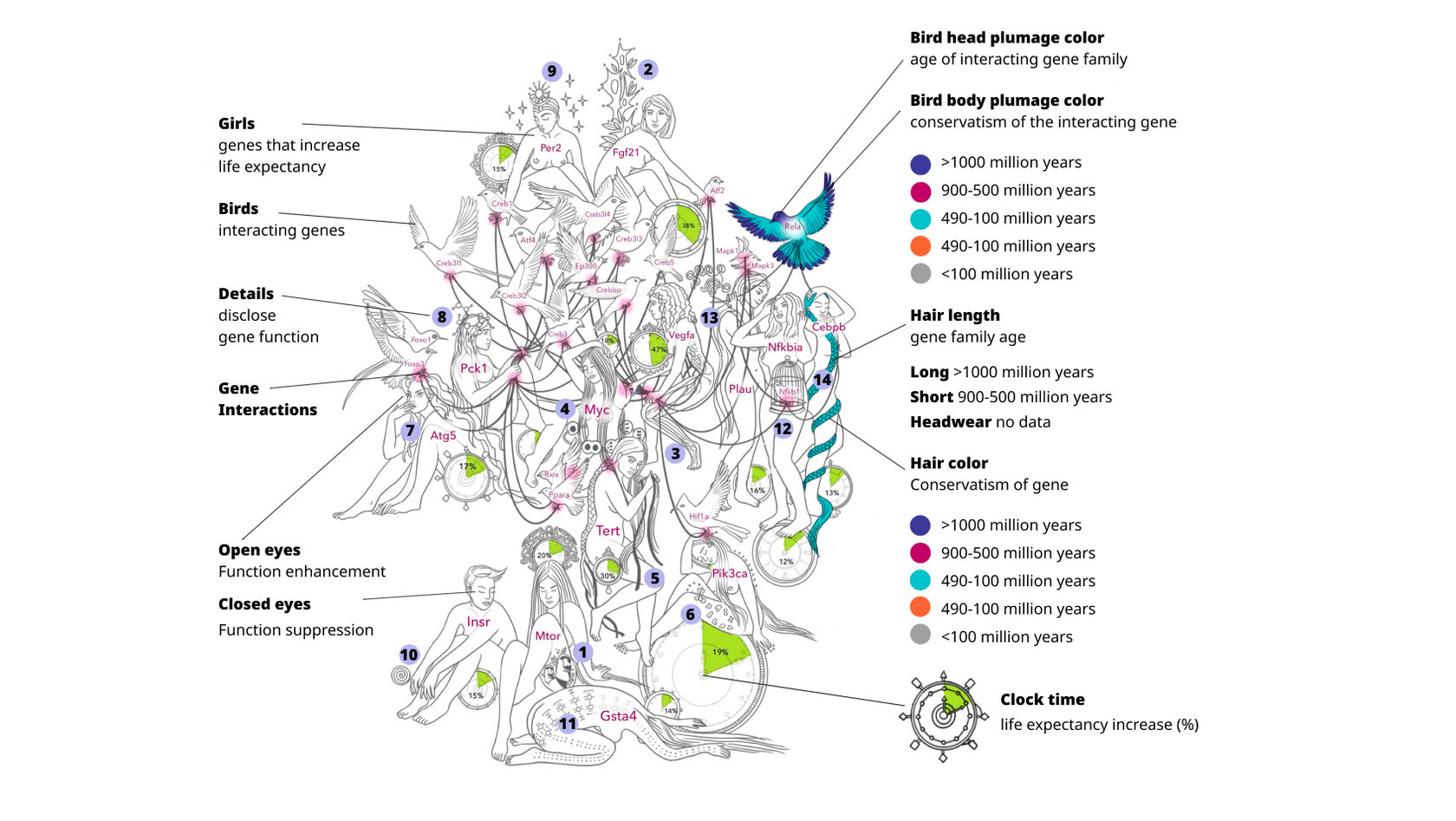We process personal information and data on users of our website, through the use of cookies and other technologies, to deliver our services, personalize advertising, and to analyze website activity. We may share certain information on our users with our advertising and analytics partners. For additional details, please refer to our Privacy Policy.
By clicking “AGREE” below, you agree to our Terms of Use and Privacy Policy , as well as our personal data processing and cookie practices as described therein. You also consent to the transfer of your data to our servers in the United States, where data protection laws may be different from those in your country.
This intricate work holds the key to unlocking the secrets of eternal youth, as it encapsulates the findings of thousands of studies on aging and longevity.
Every detail in the painting holds significance and meaning, and to fully understand it would require a scientific article.
The painting depicts young women catching birds amidst a background of clocks, symbolizing the human genes that have been shown to extend the life of mice. Unravelling the symbolism within the painting could lead to a deeper understanding of the genes that can be targeted in order to prolong human life.
At Open Longevity, we aim to create a series of "Encrypted Paintings" that will draw attention to the ongoing search for the code of immortality.
We welcome collaborations with scientists and artists to further this pursuit.
By analyzing the information within this painting, we can design experiments to extend life and bring them to fruition.
Anastasiia Velikanova, Olga Posukh, Ekaterina Rafikova and Misha Batin worked on the painting
The open eyes of the girls in the painting represent the enhancement of gene function, while closed eyes represent the suppression of gene function.
THE clocks
THE clocks
The clock next to each girl represents the time added to the mouse's life. Green sectors on the clock dials reflect the increase in life expectancy as a percentage.
THE BODIES
THE BODIES
The fully colored bodies of most of the girls indicate that the gene was expressed throughout the mouse's body, while the partially highlighted green areas on some girls suggest that the gene's activity was changed in specific tissues.

The gene is relatively young, as evidenced by the girl's short red hair. The Fgf family is found in metazoans and the Fgf21 gene itself arose as a result of duplication during vertebrate evolution. This gene was only suppressed in the liver, resulting in a one-third increase in the mouse's lifespan. This is reflected in the green highlights on the girl's body, specifically in the liver area.
The gene is relatively young, as evidenced by the girl's short red hair. The Fgf family is found in metazoans and the Fgf21 gene itself arose as a result of duplication during vertebrate evolution. This gene was only suppressed in the liver, resulting in a one-third increase in the mouse's lifespan. This is reflected in the green highlights on the girl's body, specifically in the liver area.
The Atg5 gene, which is related to autophagy, must be boosted in order to prolong life. It is depicted as a girl with open eyes and long colorless hair, as there is no data on the conservatism of this gene. The girl is depicted biting her finger, serving as a visual hint of the gene's association with autophagy.
The Pck1 gene, which codes for an enzyme that regulates gluconeogenesis, must be amplified in skeletal muscles to prolong life. This is represented by a girl with open eyes and a highlighted calf muscle area in green. The girl is depicted with a crown of glucose molecules on her head, further emphasizing the gene's role in glucose regulation.
The Pck1 gene, which codes for an enzyme that regulates gluconeogenesis, must be amplified in skeletal muscles to prolong life. This is represented by a girl with open eyes and a highlighted calf muscle area in green. The girl is depicted with a crown of glucose molecules on her head, further emphasizing the gene's role in glucose regulation.
The Per2 gene, which plays a key role in regulating circadian rhythms, must be suppressed to prolong life. This gene does not have any data on the origin of the gene family or conservatism, so the girl with closed eyes is depicted in a headdress, hiding the length and color of her hair. The headdress is decorated with images of the sun and moon, to represent the gene's role in the regulation of circadian rhythms.
The Gsta4 gene, which is involved in reducing oxidative stress, is represented by a girl with a tattoo on her back depicting the disappearing symbols of reactive oxygen species.
The Plau gene, which encodes a serine protease that converts plasminogen into plasmin, is depicted by a girl holding scissors in her hands and a strange plasminogen molecule floating nearby. To prolong life, the activity of the Plau gene should be increased in brain regions, specifically the amygdala and hypothalamus, as indicated by the highlighted green area on the girl's body.
The Cebpb gene, which encodes a transcription factor that binds to DNA molecules, is represented by a girl with a long braid that wraps around her body, symbolizing the interaction between the gene and DNA.
To view the results and detailed descriptions of life extension experiments, as well as the age of the genes, please visit the Open Genes database.

